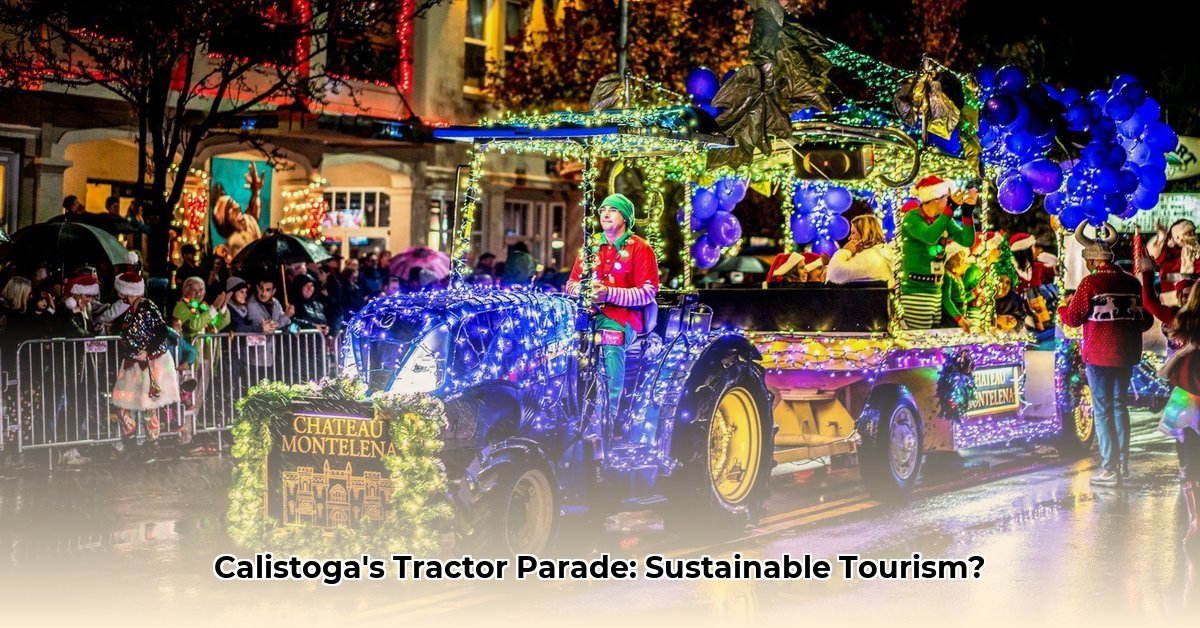
A Sparkling Night of Tractors and Community Spirit
Imagine a cool autumn evening in Calistoga, California. The usually quiet streets buzz with excitement as thousands gather, their faces illuminated by the twinkling lights adorning fifty-plus tractors. Each tractor, meticulously decorated by local residents, is a testament to community pride and agricultural heritage. The air hums with the friendly rumble of engines, festive music, and the aroma of delicious food from local vendors. This isn't just a parade; it's a vibrant community tapestry woven from shared joy and tradition. This is the Calistoga Lighted Tractor Parade—a magical blend of rural charm and modern festivity. But beyond its enchanting atmosphere, the parade offers a compelling case study in sustainable tourism.
More Than Just a Pretty Picture: The Economic Impact
The parade's charm translates into significant economic benefits for Calistoga. The 12,000 to 14,000 annual visitors—significantly outnumbering the town's 5,000 residents—inject substantial revenue into the local economy. Hotels, restaurants, and shops experience a noticeable surge in business, showcasing the power of community-focused events to drive sustainable tourism. This economic boost highlights a crucial aspect of sustainable tourism: the ability to enrich local communities while simultaneously providing a unique visitor experience. How can we build on this success, ensuring continued economic benefit?
Environmental Impact: A Road Map for Improvement
While the parade's environmental footprint is relatively small compared to larger events, opportunities for improvement exist. Currently, precise data on carbon emissions and waste generation is lacking. This gap highlights the need for comprehensive data collection and analysis. Preliminary research suggests that optimizing waste management strategies, energy consumption from lighting, and the use of sustainable decoration materials is possible. This underscores the importance of proactive planning and the adoption of data-driven approaches for optimizing the parade’s environmental performance. How can we secure the resources necessary to conduct a detailed environmental impact assessment?
Navigating Growth: Addressing Challenges & Opportunities
The parade's popularity presents both opportunities and challenges. Managing large crowds, ensuring efficient waste disposal, and seamlessly coordinating traffic flow are crucial for maintaining visitor safety and minimizing the environmental impact. Efficient waste management is paramount, and partnerships with local recycling centers could significantly improve resource management. Implementing a robust traffic management plan, potentially including designated parking areas and shuttle services, could further alleviate congestion and reduce the parade's carbon footprint. Does this necessitate seeking collaborative partnerships with regional transportation providers?
Actionable Recommendations: A Collaborative Path Forward
Success hinges on collaborative efforts. The following steps outline short-term and long-term actions for key stakeholders:
Calistoga Chamber of Commerce: Conduct a thorough environmental impact assessment; implement initial waste reduction strategies. Develop a long-term sustainability plan with measurable targets (e.g., reducing waste by 25% within three years).
Local Businesses: Implement waste reduction measures, using eco-friendly products and promoting sustainable offerings. Invest in sustainable practices (e.g., renewable energy, eco-friendly packaging).
Napa Valley Tourism Board: Promote the parade as a model of sustainable tourism; collaborate with similar events. Foster regional initiatives to promote sustainable practices throughout the Napa Valley.
Local Government: Improve waste management infrastructure; optimize traffic flow; encourage public transportation. Secure grants for sustainable event management; explore partnerships with environmental organizations.
Parade Participants: Use energy-efficient lighting; employ recycled and reusable materials in decorations. Promote sustainable practices within the community.
A Model for Rural Communities: Building a Sustainable Future
The Calistoga Tractor Parade serves as a powerful example of how rural communities can successfully integrate heritage with sustainable tourism. By addressing challenges proactively and implementing sustainable practices, this unique event can continue to thrive while inspiring other small towns to create economically vibrant and environmentally responsible tourism experiences. The ongoing commitment of the community, businesses, and local government to sustainable practices is essential to its success. Continuous improvement, through research and data-driven decision-making, will help ensure the parade’s positive impact on Calistoga and beyond for years to come.